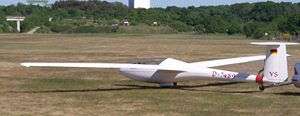Glasflügel 303
| 303 | |
|---|---|
 | |
| Role | 15 metre class sailplane |
| National origin | Germany |
| Manufacturer | Glasflügel |
| Number built | 202 |
The Glasflügel 303 Mosquito is a composite 15 metre Class single-seat sailplane manufactured by Glasflügel between 1976 and 1980.
Design and development
Designed for the 15 metre racing class, the Mosquito replaced the Libelle in Glasflügel's production line. It married the Standard Class Hornet fuselage with a new flapped wing employing the ubiquitous FX 67-K-150 airfoil. The wing featured innovative interconnected trailing edge dive brakes-variable camber flaps. The glider had automatic connection for all controls: ailerons, elevator, air brakes and water ballast.
The maiden flight of the Mosquito took place in 1976. It is by all accounts a nice-handling, comfortable and pleasing aircraft, but a little less performing than the contemporaneous Rolladen-Schneider LS3 and ASW 20. Therefore, the Mosquito (and the Schempp-Hirth Mini-Nimbus that shares the same wing) did not do well in top level competition, neither did it find the large commercial success of the Libelle. The Mosquito was superseded in 1980 by the Glasflügel 304.
The 303 Mosquito is often referred to as the H303 or H-303. This is incorrect, as the H designates gliders designed for Glasflügel by the Hütter brothers. (Is this really correct? The Salto was designed by Ursula Hänle and is known as the H-101. The wings of the dragonfly that is the Glasflügel logo are two "H"s. These represent the surnames of Glasflügel's founding partners, Ulrich Hütter and Eugene Hänle. A reference for this statement???).
Aircraft on display
Specifications
General characteristics
- Crew: One pilot
- Capacity: 125 kg (275 lb) water ballast
- Length: 6.40 m (21 ft 0 in)
- Wingspan: 15.00 m (49 ft 3 in)
- Height: 1.40 m (4 ft 7 in)
- Wing area: 9.86 m2 (106 ft2)
- Aspect ratio: 22.8
- Empty weight: 242 kg (532 lb)
- Gross weight: 450 kg (990 lb)
Performance
- Maximum speed: 250 km/h (160 mph)
- Maximum glide ratio: 39
- Rate of sink: 0.5 m/s (100 ft/min)
See also
Aircraft of comparable role, configuration and era
Related lists
References
- ↑ US Southwest Soaring Museum (2010). "Sailplanes, Hang Gliders & Motor Gliders". Retrieved 26 May 2011.
- Thomas F, Fundamentals of Sailplane Design, College Park Press, 1999
- Simons M, Segelflugzeuge 1965-2000, Eqip, 2004
External links
| Wikimedia Commons has media related to 303 Mosquito. |